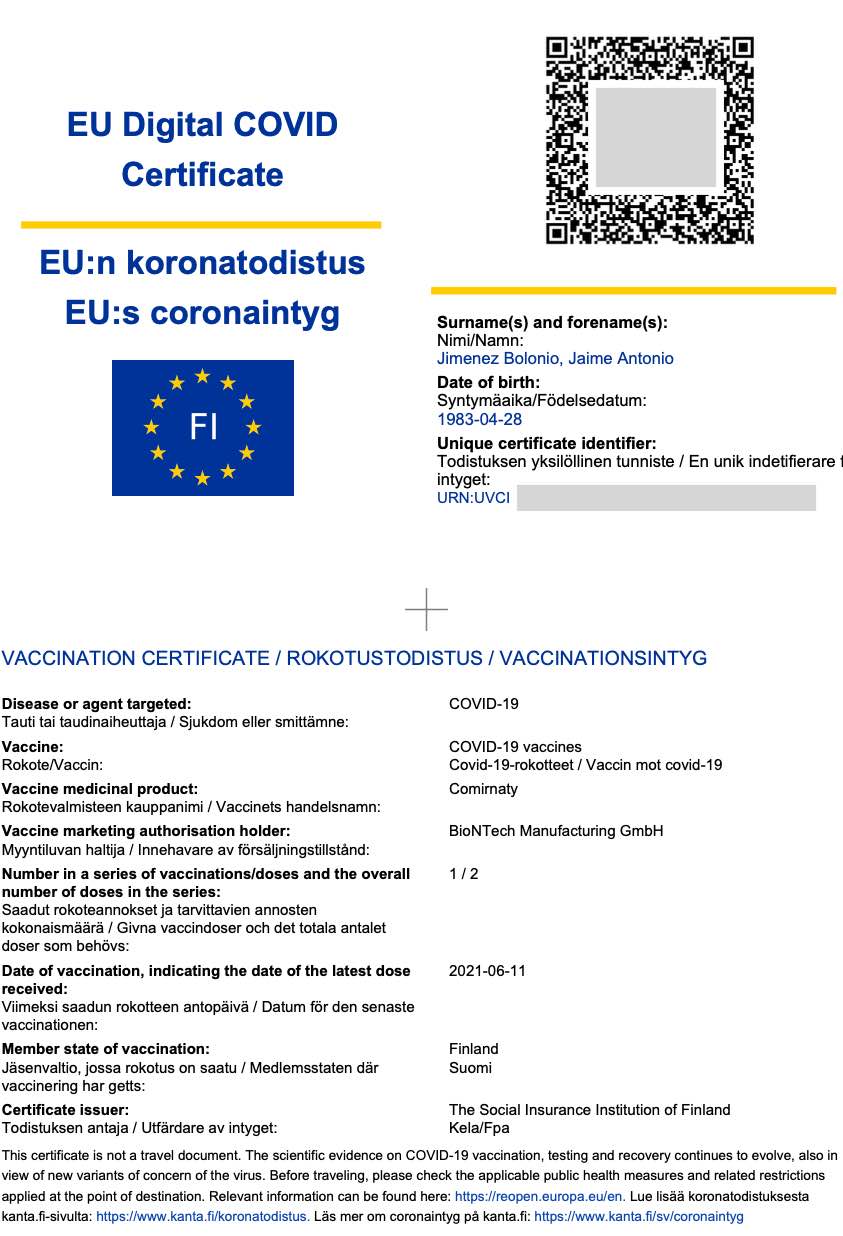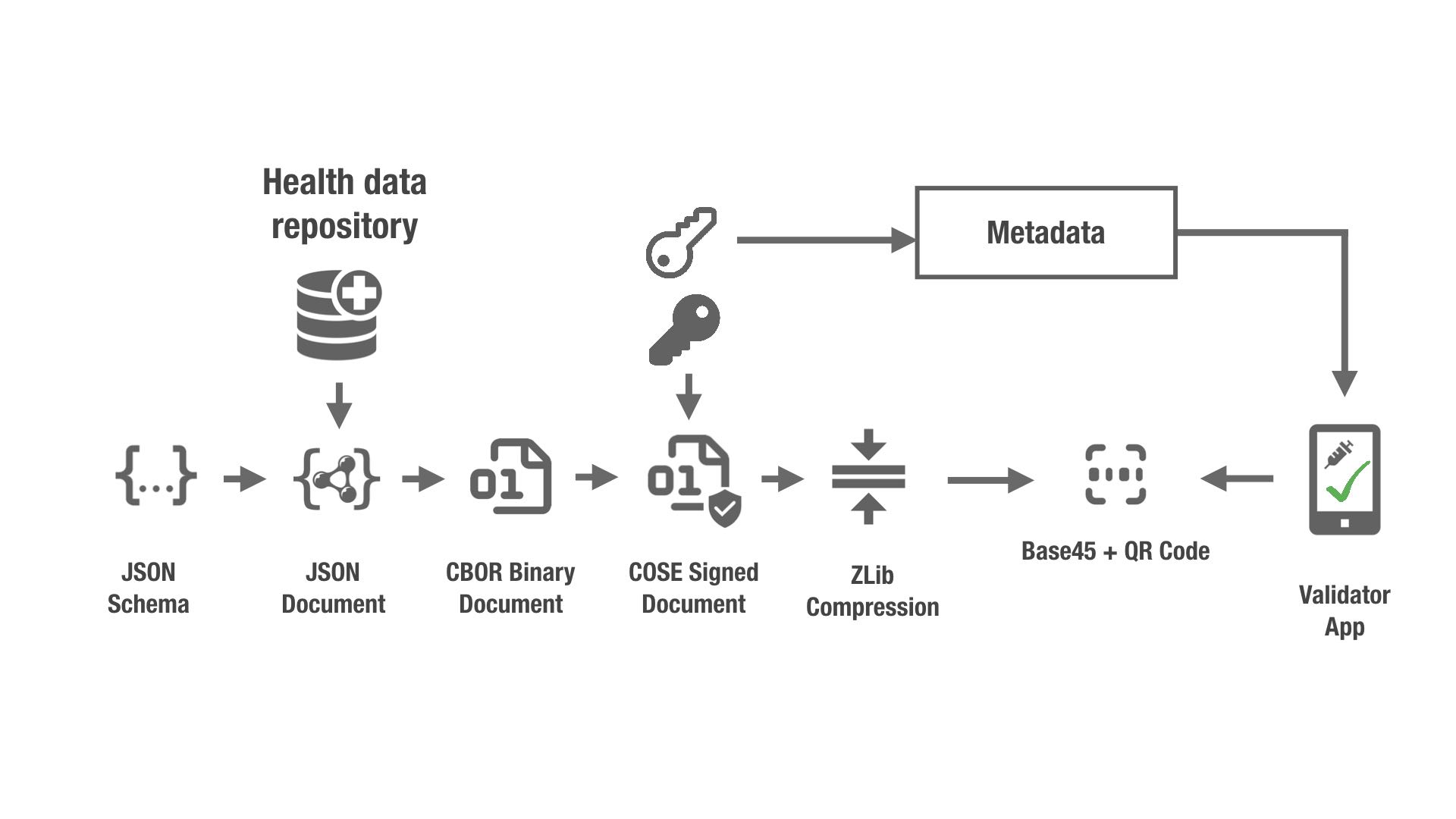
Electronic Health Certificates and IETF
- 6 minsI have written nothing about COVID and the two anni horribiles we are having. So let this be the first and last post about the topic.
I got today a EU CoVID certificate from the Finnish Health Service (kanta.fi). The certificate pdf contains plaintext identification information, details of the COVID-19 vaccination and metadata to identify a valid certificate. It comes with a unique URN identifier and a QR code (or Aztec Code) that encodes the same information and can be verified by a validator application.

I could not resist trying to look into the QR code with a well-known qr code reader called zbar.
~ zbarimg --raw qr.png (678ms)
HC1:NCFOXN%TSMAHN-HMR blablablablablaba :VC/4
scanned 1 barcode symbols from 1 images in 0.02 seconds
I was curious, as this was not just your average URL encoded into a QR, it had some sort of header, the HC1:NCFOXN%, which I promptly googled for. It turned out that you can find the EU Digital Green Certificates (DGC) project as well as the full certificate specification!. There are even available implementations for Electronic Health Certificates (HCERT) - which I have not tested-. It also comes with a neat rationale for the technology choices they made.
You can find lots of examples on the EHN github repository. For example, here you have a valid HCERT example of someone with one vaccination. It includes the full chain from the JSON, CBOR, the COSE signed as well as the BASE45 with the HC1 prefix.
There is also a document by the World Health Organization on the trust model for these certificates. As I come from the IoT angle, many of the steps are reminiscent of an IoT device onboarding process, but that’s another story.
They show the general process and structure of the HCERT creation, signing and validation:
- Encode vaccination information on a JSON structure using CBOR.
- Sign it with COSE and the private key of one of the Country Signing Certificate Authorities (CSCA) Signer Certificates. There are no CAs or other intermediate parties, valid keys are published online. This is the same principle used in over 490 million ePassports in circulation.
- The resulting document is compressed some more with zlib. Although this is useful specially in cases with many vaccinations.
- They transform it to base45 for certain reasons and generate a QR with that.

So now I know that the information from the QR code is a base45 data structure with a 3-byte header HC1 for Health Certificate Version 1. It would be expected that after decompressing with zlib , we would obtain CBOR/COSE binary data.
I tinkered around, trying few base45 decoders, removing the header and getting up to the zlib decompression phase. It is at this point that I found the excellent post by Tobias Girstmair who has worked much more with this already. So I simply run his script that reads the QR, extracts the data, transforms the base45, removes the COSE signature and reads the CBOR, presenting the actual data. Which is as follows:
root@93955752b07d:src/docker-ubuntu# python3 greenpass.py qr.png
QR Code Issuer : FI
QR Code Expiry : 2022-06-22 20:59:59
QR Code Generated : 2021-06-22 06:48:13
Vaccination Group
Unique Certificate Identifier: UVCI : URN:UVCI:01:FI:********************
Country of Vaccination : FI
Dose Number : 1
ISO8601 complete date: Date of Vaccination : 2021-06-11
Certificate Issuer : The Social Insurance Institution of Finland
Marketing Authorization Holder : ORG-100030215
vaccine medicinal product : EU/1/20/1528
Total Series of Doses : 2
disease or agent targeted : 840539006
vaccine or prophylaxis : J07BX03
Date of birth : 1983-04-28
Surname(s), forename(s)
Surname : Jimenez Bolonio
Forename : Jaime Antonio
Standardised surname : JIMENEZ<BOLONIO
Standardised forename : JAIME<ANTONIO
Schema version : 1.0.0
The output is self-explanatory for the most part, and matches the plaintext information. When it comes to the disease and the vaccine numbers, they are part of a classification system. So 840539006 stands for COVID-19 disease and J07BX03 which is used for all Covid19 vaccines (Moderna, Pfizer, Astrazeneca…). The specific vaccine is defined by the EU/1/20/1528 field which is BioNTech Pfizer in my case.
During the tinkering I was pleasantly surprised to see use a lot of IETF-made technologies like CBOR, COSE, CWT, Base45, etc. Many of these -as far as I know- were initially intended for Internet of Things (IoT) as they focus on being lightweight and require little processing. Why did they chose IETF technologies? Well part of their guiding principles are right on the IETF ballpark:
2 . Use an encoding which is as compact as practically possible whilst ensuring reliable decoding using optical means.
3 . Use existing, proven and modern open standards, with running code available (when possible) for all common platforms and operating environments to limit implementation efforts and minimize risk of interoperability issues.
The creators seem also looking at the edge of the standardization as they are using an IETF draft format for the base45 encoding and not an existing RFC. The news were also shared on a IETF mailing list by the creator of CBOR.
It gives a very odd feeling to be a tiny part of the story of the creation of these technologies and to watch how they come from an idea to a reality.
Update 03.08.2021
Incidentally, the finnish authorities are now issuing PCR test certificates using the same underlying technology as the one used in the COVID certificates, thus making them unforgeable. The personal information is the same but there is now data about the type of test done and its results.
For example, using the EU Green Certificates specification we can determine that I got a Nucleid acid amplification test or LP6464-4 and that the Covid variant was “not present” (260415000).
QR Code Issuer : FI
QR Code Expiry : 2022-08-03 20:59:59
QR Code Generated : 2021-08-03 16:24:36
Test Group
Unique Certificate Identifier, UVCI : URN:UVCI:01:FI:********************
Country of Test : FI
Certificate Issuer : The Social Insurance Institution of Finland
Date/Time of Sample Collection : 2021-07-30T16:01:00+03:00
Testing Centre : Espoon kaupunki, sosiaali- ja terveystoimi
tg : 840539006
Test Result : 260415000
Type of Test : LP6464-4
Date of birth : 1983-04-28
Surname(s), forename(s)
Surname : Jimenez Bolonio
Forename : Jaime Antonio
Standardised surname : JIMENEZ<BOLONIO
Standardised forename : JAIME<ANTONIO
Schema version : 1.3.0